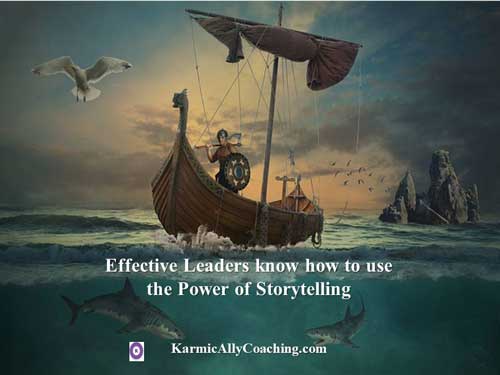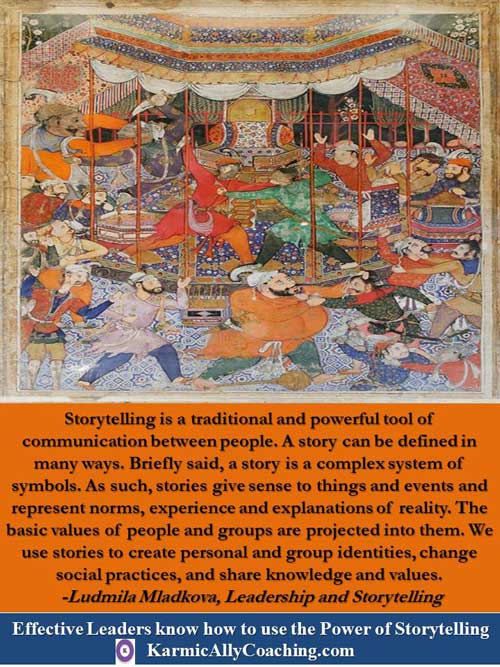This post has already been read 3156 times!

What is your favourite childhood story book – the one that made your imagination come alive? Was it Grimm’s Fairy Tales, Aesop’s Fables, Jataka Tales or a specific story? Or were you an Enid Blyton fan?
Sometimes there were lessons to be learned in those stories. Like the ones in the Panchatantra where the heroes are animals behaving like humans. We learn from their experiences.
Now think back a little more and remember who was your favourite storyteller. Was it a parent, grandparent or teacher?
I’m willing to bet that whoever your favourite storyteller was, had a powerful influence on your life. The stories they told you addressed emotions and created a new world with new ideas for you. In many ways they were your leader as they opened up a realm of dreams for you.
We visualized the Hero on his Adventure and how he or she resolves the conflicts on their path to Success. Our subconscious mind registered the strategies and tactics for future use in the real world.
There’s always a moral of the story and this social and moral norm gets embedded in a young growing mind through the medium of a narrative.
In the Hindu tradition, the Ramayana is read and enacted in play form as are other Hero Journey stories for specific Gods to bring home the teachings that these Gods and their stories stood for.
Storytelling is a traditional and powerful tool of communication between people. A story can be defined in many ways. Briefly said, a story is a complex system of symbols. As such, stories give sense to things and events and represent norms, experience and explanations of reality. The basic values of people and groups are projected into them. We use stories to create personal and group identities, change social practices, and share knowledge and values.
–Ludmila Mladkova, Leadership and Storytelling
In fact, we tell stories even in our day to day lives.
Our stories determine what we accept, how we see the world and influence our responses.
If you read my blog posts, more often than not, there is a story behind the point being communicated in that post from my perspective based on experience.
For example, imagine how bland a post on corporate politics would be if I didn’t share a story and simply dished out tips and points to follow?
You do it too even if you aren’t aware of the special meaning of your stories. With the advent of social media, you are sharing your story with the world through your updates whether they are happy ones, rants or even selfies!
Given the power of storytelling, it is not surprising that leaders often use storytelling to share their knowledge, explain new ideas, create new visions and influence their teams to strive for excellence by creating a group identity.
There is research being conducted to determine the relationship between leaders and storytelling. Modern research indicates that a leader can use stories and storytelling for:
- Explanation of ideas
- Smooth the implementation of change
- Communication improvement
- Tacit knowledge sharing
- Intensification of innovation
- Community and team building
- Planning
- Creation of scenarios and visions
- Coaching and training
- Communication with clients and other stakeholders
- Trust building
- E-learning and many others
How to tell a great story as a Leader

My favourite source for Leadership Storytelling is Steve or Stephen Denning, Author of The Leaders Guide to Storytelling: Mastering the Art & Discipline of Business Narrative.
According to Mr Denning, in order for a leader to create change using the medium of storytelling, the leader has to first focus on the priority change message and be clear about the problem that is being addressed and how the world would look like when the problem is resolved.
This is only 1 part of the change because the leader also has to understand the story of the follower in order to determine where possible resistance can crop up.
I remember a boss from my corporate world days with the habit of launching into war stories during critical deadlines. The team shuddered to go into his office for any clarification because it would become what we called in Hindi a gyaan session. (Gyaan means knowledge in Hindi, but in the office lingo of that time, it was used in a more sarcastic sense).
He was a boss who could have taught his team a lot more, but we never looked up to him as a Leader.
The stories were meant to encourage us in our firefighting and meeting tough deadlines but only added to delaying the work and adding stress.
In hindsight, I believe it was because he had not bothered to check on the timing of his story or the needs of the story listener.
The stories a leader shares aren’t supposed to be war stories which in a situation of change will be time wasters for the follower.
They are supposed to be stories that will get the attention of the listener and create the desire for change within them. Once the emotional and creative appeal has been established, it becomes easier to reinforce the desired outcome with logic, reason and rationale.
Annette Simmons has identified 6 kinds of stories that can be used depending upon the context of the situation to facilitate effective communication within a group by bringing the group members together, sustain values, promote mutual respect and increase productivity:
“Who I Am” Stories
“Why I’m Here” Stories
“Vision” Stories
“Values in Action” Stories
“Teaching” Stories
“I Know What You’re Thinking” Stories
A story is only as good as the storyteller.
Remember I asked you earlier about your favourite storyteller in your childhood?
I’m willing to bet it wasn’t the stories they told but the way that they narrated the story.
Similar principles apply here too – without too much theatrics, of course.
In other words, maintain eye contact, use appropriate body language, an open stance, pause for effect and sound like you really mean the story. Let your passion shine through for the story.
The right story in the right context can work wonders. It can tap into the emotions of the listener but depending upon how it is narrated, it can do more harm than good.
In my post Helicopter View – You need to see the Big Picture for Success, I narrated how our Managing Partner took the stage to break the news of changes in our firm and how he ended up terrifying us.
He told his Vision Story with passion, walking all over the stage but had not taken his audience’s story into account or presented facts in a concrete or specific manner. If the intention was to have gotten us thinking, it certainly did but not in the direction that he had imagined!
Storytelling is a valuable tool for Leaders and aspiring Leaders. I’ve included additional resources and book recommendations at the bottom of this post.
For now, I want you to reflect on the guidance in this post and tell me, do your stories demonstrate your Leadership skills.
Storytelling and Leadership – Additional Resources
The Leaders Guide to Storytelling: Mastering the Art & Discipline of Business Narrative: Stephen Denning
The Story Factor: Inspiration, Influence, and Persuasion Through the Art of Storytelling: Annette Simmons
7 Tips for great storytelling as a Leader: Dianna Booher
How to use storytelling as a Leadership Tool : Dan Schwabel




 I adhere to the Certified Coaches Alliance Code of Ethics and Standards. A copy is available on request.
I adhere to the Certified Coaches Alliance Code of Ethics and Standards. A copy is available on request.
 Let's Talk through the Connect Form:
Let's Talk through the Connect Form:
Well said Vatsala…Storytelling indeed is an art and can be learned with practise….If you see in political context, two politicians name come to my mind who are great in the art of storytelling – Barak Obama and Narendra Modi…fascinating to hear these politicians and how they weave the story….
Thanks for the post…
Thank you for visiting the Karmic Ally Coaching Blog Amit and adding to the conversation. You are right about Obama and Modi – storytellers who know how to get their message across.
This is a great post affirming the role of storytelling for leaders, which most of us as business owners are. Found the strategies and tips you mentioned, including the ones you incorporated from the book, valuable for me to also incorporate into any of my speaking opportunities.
Thanks for the post and content.
Delighted to know you will be using and incorporating the strategies and tips in your future speaking opportunities, Yvonne. The books are a must read for any leader who wants to make a difference.
What I love about your piece is that in both instances where the stories missed their mark it had to do with connecting in with the audience – being present and ensuring that your message is meeting it’s mark.
I will definitely put more thought into the stories I want to share and how they are being perceived.
Absolutely true, Anita. In both instances the timing, context and connection were out of sync. The worrying part in both stories is that these guys were supposed to lead and yet look what happened!
I love this- I know i need to do more storytelling- thanks for the prompt. I was an Enid Byton fan BTW thank you i am thinking xxoo
Another Enid Blyton fan! 🙂 Looking forward to reading your stories, Suzie.
Hi Vatsala, I totally agree and this is a wonderful post! Storytelling builds that connection and I think answers the question, “well why should I listen to you??” 😉 Sending love and am happy to share! xoxo Jenny
Thank you Jenny! The right story in the right context also helps build rapport with the listener and when in teaching mode, helps to demonstrate that we have walked in the listener’s shoes before and can be trusted, hence they can learn by listening to us.